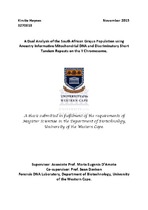| dc.contributor.advisor | D’Amato, Maria Eugenia | |
| dc.contributor.advisor | Davison, Sean | |
| dc.contributor.author | Heynes, Kirstie | |
| dc.date.accessioned | 2016-06-06T09:18:57Z | |
| dc.date.available | 2016-06-06T09:18:57Z | |
| dc.date.issued | 2015 | |
| dc.identifier.uri | http://hdl.handle.net/11394/5056 | |
| dc.description | >Magister Scientiae - MSc | en_US |
| dc.description.abstract | The primary objective of this Masters project was to investigate the maternal ancient substructure of the Griqua population in South Africa. Genetic ancestry was determined by investigating ancestry informative single nucleotide polymorphisms. These are located in the control region of the mitochondrial genome. The auxiliary aim was to test the validity of the UWC 10plex system in relation to a sample group of Griqua males. This short tandem repeat multiplex targets specific mutations confined to paternal lineages. The Khoi Khoi or Hottentots were the first inhabitants in the Cape. Indigenous Khoi Khoi female slaves had offspring with the European settlers in the 1800s which resulted in the Griqua population group. The incorporated European paternal ancestry is what set the Griqua apart from the native population groups at that time. Colonisation events from the mid-17th to 19th Century and the apartheid regime resulted in land dispossession of the native population and an extensively mixed gene pool in South Africa. One hundred and seventy six (N=176) male and female Griqua people were collectively sampled in Kokstad (2012), Vredendal (2012 and 2013) and at the Griqua National Conference in Ratelgat (2013). All 176 samples were analysed using mtDNA control region Sanger sequencing. The sample group (N=176) was separated based on birthplace (Origin sample group and post-colonial sample group). The origin sample group consists of individuals whose ancestors were not part of the Griqua Trek to Northern regions of South Africa and were less likely to be exposed to colonial influences. Mutations within the hypervariable segments of the mtDNA control region were used to infer haplogroups with geographic-specific population data. In this way one can plot the extent of ancient Khoisan (L0d) and Bantu influences (L1-L5) as well as the influence of East (M, A, B, E) and West (N, R, J, H) Eurasian haplogroups in the maternal ancestry of the Griqua population group. The origin sample group showed 91% African ancestry (76.8% L0d) while the post-colonial group had 78% African ancestry (60% L0d). The origin sample group had 2% East Eurasian and 7% West Eurasian ancestry, while the post-colonial group contained 20% Eurasian ancestry. There is greater admixture in the post-colonial group which can be attributed to the integration of surrounding populations during settlement periods in parts of the Northern Cape and KwaZulu-Natal. The UWC 10plex STR kit was tested to see if it could discriminate between male individuals of this admixed sample group (N=91 males). The markers for this multiplex were selected according to their ability to differentiate between individuals of African descent. It proved to be a viable Y chromosome short tandem repeat testing tool, displaying a statistically significant discrimination capacity value of 0.966 and only having 3 shared haplotypes in the sample group of 91 Griqua males. | en_US |
| dc.description.sponsorship | National Research Foundation (NRF) | en_US |
| dc.language.iso | en | en_US |
| dc.publisher | University of the Western Cape | en_US |
| dc.subject | Griqua population | en_US |
| dc.subject | Single Nucleotide Polymorphisms | en_US |
| dc.subject | Mitochondrial DNA control region | en_US |
| dc.subject | Y chromosome Short Tandem Repeats (Y-STRs) | en_US |
| dc.title | A dual analysis of the South African Griqua population using ancestry informative mitochondrial DNA and discriminatory short tandem repeats on the Y chromosome | en_US |
| dc.rights.holder | University of the Western Cape | en_US |

